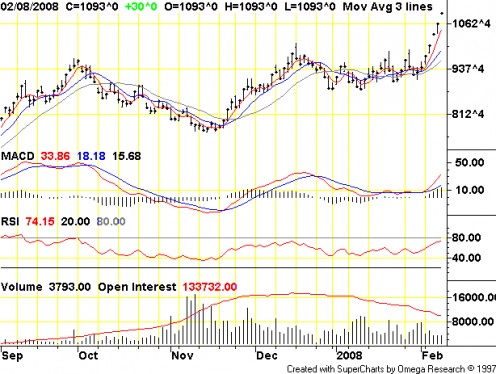Futures Trading Part 2 - What Are Futures Contracts?
Commodity Futures Price Chart

What Are Futures Contracts?
Futures trading - Contracts and Other Peoples' Money
Not surprisingly, records survive of futures transactions in ancient Mesopotamia and Egypt, as well as Greece and Rome. The futures trading contract is as old as organized agriculture, which is to say as old as civilization itself. That is because the problem that futures contracts solve has remained the same throughout history. To return to the example of the loaf of bread in your local supermarket, a huge infrastructure is in place to get that loaf of bread, and millions like it, from the farm to the silo and mill, to the warehouse and bakery, to the distributor and retailer. This includes an armada of trucks, tractors, threshing and kneading equipment, ovens, yeast cultivation equipment, countless millions of acres of land, and experienced tradesmen and merchants who’ve based their lives on the steady flow of wheat from the farm to the loaf of bread that you buy at your local supermarket.Suppose, however, that the farmer invested a total of $3.50 a bushel in planting, cultivating, harvesting and shipping his wheat crop to market. Suppose further that by the time the fruit of his labors gets there, the price of wheat has dropped to $3.24. He can’t go back six months in time and un-plant his field. Once his farm is committed to wheat, he’s pretty much stuck. So he’d have to sell at a loss, default on some loans or tighten his belt, perhaps lose his farm altogether and live miserably ever after. Rather than run such a foolish risk, at planting time or even before, the hypothetical farmer finds a buyer at a predetermined price, say $3.60 a bushel for 5,000 bushels to be delivered by September 15, 2008. After the farmer takes a good faith deposit (nowadays, $1,293) from the purchaser, they are both locked in at that price regardless of what the market value of 5,000 bushels turns out to be on September 15, the delivery date. This is what has come to be known (in commodity future trading parlance) as a futures contract. The ancient Mesopotamian farmer and the merchant who bought from him had another name for it, but it performed the same service for him as futures contracts now do for the modern-day farmers that are trading commodities, as well as the oil tycoons, miners, ranchers and merchants who deal in the other essential commodities - stabilizing prices to make it safe for them to do business. By way of example, suppose that on September 15 the price of wheat has gone up to $3.75 a bushel. The farmer has still made a profit at $3.60 a bushel, and he has been safeguarded against possible losses that thankfully did not materialize. Taking the flip side of the coin, the merchant to whom the farmer sold his wheat at $3.60 a bushel can turn around and sell it to someone else for $3.75, pocketing a tidy profit. But if the price of wheat instead fell to $3.45 a bushel by September 15, the merchant (who agreed to pay $3.60 a bushel) would then have lost money, and the farmer would come out ahead, rather than behind.This sort of arrangement, as outlandish as it may look at first glance, is really quite commonplace. When we make hotel and plane reservations months in advance, we are similarly hedging against abrupt rises in prices, and we also pay a good faith deposit. A landlord of my acquaintance paid in advance for several thousand dollars worth of heating oil shortly before the start of Gulf War II, thereby protecting himself against price hikes. His oil supplier was locked in at the pre-war price. When a real estate speculator buys an option to purchase a house, he is locking the seller in at a lower price, confident that the fair market value will rise, at which point he’ll either exercise his option or sell it at a profit to somebody else, who will then exercise it. If the market value stays the same, the speculator either lets his option expire, or sells it at a discount.But returning to commodity trading and the example of wheat futures, suppose the price of wheat drops to $3.24/bu and the merchant doesn’t care to buy at $3.60/bu, which is above market value and would make him lose money - is he stuck? Of course not. Prior to September 15, anticipating the fall in prices, he could simply sell his futures contract to a different merchant, the open contract’s $1,293 margin price reduced to make up for the drop in the actual commodity’s price. Or, he could enter into a different contract to sell wheat, thereby “closing out” the “long position” of his original futures contract. (I.e., since he has a contractual obligation to sell 5,000 bushels of wheat and also has an obligation to buy 5,000 bushels of wheat, it’s a wash, so he can satisfy both contracts by doing nothing).Neither is the farmer in a suicide pact. If he thinks prices might go to $3.75/bu, above the $3.60/bu price to which he agreed to in advance, he could sell his futures contract to any willing farmer or merchant, again making an adjustment for price fluctuations. If the price of wheat is expected to rise, he would sell his contract at a discount, since it imparts the obligation to sell for less than the market price. If wheat prices are supposed to fall, he would sell his contract at a premium, since it imparts the right to sell at above market prices.He could also enter into a separate contract to buy wheat, and thereby “close out” his “short position”.These contracts are extremely useful to merchants and other producers of the various commodities. That is why in the United States for the past 100 years, the most important futures trade contracts have been publicly traded at federally regulated clearing houses called 'Exchanges'. Consequently, these Exchanges have attracted speculators trying to make money by profiting from the fluctuation of commodity prices, but with no real interest in the actual commodities they are futures trading. The same thing happened in Mesopotamia.More Info...
- Futures Trading Part 1
Futures Trading: Commodities, the Source of All True Wealth - Futures Trading Part 3
Futures trading - Leverage and the Power of Multiplication



